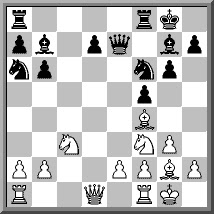Svein was the first Norwegian player of international strength and would easily have become an GM if tournament opportunities in the 1950s and 1960s had been more like what they are today. During long periods of his life Svein was part of the inventory in Oslo Schakselskap's playing venues in Bogstadveien 30 - mostly to be found playing blitz or looking up games or studies in old chess magazines. His play was always refreshingly free from routine moves and schematic thinking - even in his old years with the clock ticking away a little too quickly. I picked the game below partly because the opening interests me but I also think it's quite typical of his style of play:
James Aitken - Svein Johannessen, Tel Aviv ol (Men) B-final 1964
1.e4
Svein's opponent in this game was somewhat past his prime but had some 25 years earlier taken a few nice scalps from world class opposition.
1...c5
Although the Norwegian Variation (1.e4 e5 2.Nf3 Nc6 3.Bb5 a6 4.Ba4 b5 5.Bb3 Na5) to some extent became Svein’s trademark variation, he had a very varied repertoire, and always seemed more comfortable in the semi-closed and semi-open games.
2.Nf3 e6 3.d4 cxd4 4.Nxd4 a6!?
This is the Kan variation - an opening for which I have always had a soft spot. Unfortunately my score with it is rather catastrophic and a very good reason for me to avoid it in serious games.
5.Nc3 Qc7
Opening terminology can be quite confusing. If Black here plays ...Nc6 and ...Nge7 the line is often called the Taimanov variation.
Another option which has fascinated me lately is 5...b5!?, possibly followed by ...Qb6, attacking the knight on d4, and only after Nb3, to play ...Qc7 (or even ...Qb8). It can occasionally be very hard to tell who has lost or won a tempo, as White frequently withdraws his d4-knight voluntarily in order to keep some pressure in the open d-file.
6.g3
This modest-looking move is third in popularity after 6.Bd3 and 6.Be2 and quite logical as there are some tactical shots in the h1-a8 diagonal.
6...b5
Around the time when this game was played, Svein experimented with other moves at this point:
a) 6...Bb4 7.Nde2 Ne7 8.a3 Bc5 9.Bg2 Nbc6 10.0–0 0–0 11.Kh1 Rd8 12.Nf4 b5 13.Nd3 Ba7 14.a4 bxa4 15.Rxa4 Bb7 16.Bf4 d6 = Gaprindashvili-Johannessen,
b) 6...Nf6 7.Bg2 Nc6 8.Nb3 (8.0–0 Be7 9.Kh1 0–0 10.Be3 d6 11.f4 Bd7 12.Qe2 Rac8 13.Rad1 b5 = Duraku-Johannessen,
7.Bg2 Bb7 8.0–0 Nf6 (Dia)
9.a3?!
This slow move isn’t really necessary. More to the point is 9.Re1!
a) 9...b4 10.Nd5! demonstrates White’s tactical point. After 10...exd5 11.exd5+ Kd8 12.Bg5 Bc5 13.Nf5 h6 14.Bxf6+ gxf6 15.Qg4 Kc8 16.Qg7 White had plenty of compensation in Vesselovsky-Hrivnak,
b) Probably 9...d6 10.a4 b4 (10...bxa4 11.Nxa4 Be7 12.Bd2 0–0 13.Nb3 Nc6 14.Be3 Nd7 15.Qd2 Nce5 16.Na5 Nc4 17.Nxc4 Qxc4 18.Nb6 Nxb6 19.Bxb6 Rfc8 = Unzicker-Mariotti, Milan 1975) 11.Nd5! is of greater theoretical interest: 11...exd5 12.exd5+ Kd8 13.Bg5 Nbd7 14.Qe2 Qb6 15.c3 Ne5 16.a5 Qc5 17.Nc6+ Kc8 18.Be3 and White was winning in Smirin-Gelfand, Sverdlovsk 1987. The game concluded 18...Qb5 19.Bh3+ Nfd7 20.Bxd7+ Kxd7 21.Nxe5+ Kc8 (21...dxe5 22.c4) 22.c4 1–0 .
9...d6
Now the game merges with other lines where Black has played an earlier ...e6. 9...Nc6!? could be an attempt to take advantage of White’s slow 9th move.
10.Qe2
Probably White should consider one of the alternatives in order to fight for an advantage:
a) 10.f4 Nc6 11.Nb3 Be7 12.Be3 0–0 13.Qe2 Na5 14.Nxa5 Qxa5 15.Rfd1 Qc7 16.Rd2 Rfd8 17.Rad1 += Panov-Kotov,
b) 10.Re1 Be7 11.a4 (11.g4?! h6 12.h4 g6 13.g5 hxg5 14.hxg5 Nh5 15.Nde2 Nc6 16.Be3 Ne5 =+ Mueller-Bologan, Oakham 1992) 11...b4 12.Na2 0–0 13.Bg5 Nbd7 14.Qd2 a5 15.Nb5 Qb6 16.c3 Nc5 17.Bxf6 gxf6 18.Nd4 bxc3 19.Nxc3 Rab8 unclear Topalov-Short,
10...Nbd7
The game Koskinen-Barda,
11.Nb3 Be7 12.f4 Rc8 13.Be3 0–0 14.Kh1
14.Rfd1 Rfd8 15.Rac1 Nb6 16.Na5 Ba8 17.h3 d5 18.e5 Nfd7 19.Na2 Nc4 20.Nxc4 Qxc4 21.Qxc4 bxc4 was unclear Holeksa-Zajic,
14...Nb6 15.Na5 Ba8 16.Rad1
After 16.Bxb6 Qxb6 17.Nb3 Rfd8 Black seems a little more comfortable thanks to his bishop-pair.
16...Na4 17.Nxa4 bxa4 18.Qxa6 Nxe4 (Dia)
Now it’s obvious that Black has won the opening duel. This is the kind of central majority he normally can only dream about - even in the Sicilian.
19.c4?!
19.c3 would have been somewhat better.
19...Rb8 20.c5
Black’s tactical point was 20.Rb1 Nd2! 21.Bxd2 Bxg2+ 22.Kxg2 Rb6 which traps the queen.
20...Nxc5 21.Bxc5 Bxg2+ 22.Kxg2 Qxc5 23.Nc4 d5 24.Nd2 Rxb2 25.Qxa4 Qe3 26.Qa5 Bd8 0–1








